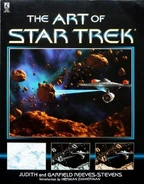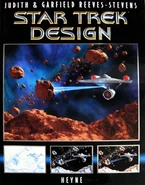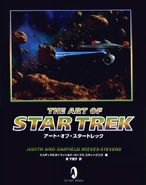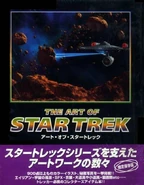m (→Summary: grm.) Tag: sourceedit |
m (grm.) Tag: sourceedit |
||
| (4 intermediate revisions by the same user not shown) | |||
| Line 48: | Line 48: | ||
==Background information== |
==Background information== |
||
*Heavily illustrated with depictions of the material in question, the book was, in its first edition, presented as (one of the first) high-quality bound hardcover coffee table books, format 30.2×23.4×2.6 cm, in a dust jacket. The quality was reflected in the production value of the book, with high resolution full-color pictures printed on heavy high-gloss paper. |
*Heavily illustrated with depictions of the material in question, the book was, in its first edition, presented as (one of the first) high-quality bound hardcover coffee table books, format 30.2×23.4×2.6 cm, in a dust jacket. The quality was reflected in the production value of the book, with high resolution full-color pictures printed on heavy high-gloss paper. |
||
| − | *The cover art has been a collaborative effort; Production Illustrator [[Jim Martin]] designed the art, executing it in a series of progressive pencil sketches. The art was subsequently turned over to freelancer Mikido Uesugi and [[John Knoll]] of [[Industrial Light & Magic]] (who was working on {{film|7}} at the time) who enhanced Martin's art digitally as a |
+ | *The cover art has been a collaborative effort; Production Illustrator [[Jim Martin]] designed the art, executing it in a series of progressive pencil sketches. The art was subsequently turned over to freelancer Mikido Uesugi and [[John Knoll]] of [[Industrial Light & Magic]] (who was working on {{film|7}} at the time) who enhanced Martin's art digitally as a quasi-[[CGI]] effect. Jacket design was by James Wang. |
| − | *As one of the very first officially-licensed books in this coffee table format, collecting production material straight from the source – the [[CBS Consumer Products|CBS/Paramount archives]] where a wealth of material was stored – this book was bound to contain inaccuracies and has received scrutiny from, among others, [[Andrew Probert]], whose work was also prominently featured in the book. He commented, "''One example would be showing the ''Enterprise''-D that I designed in its original proportions and the ''Enterprise'' with [[Gene Roddenberry|Gene]]'s requested changes, whereby Gene asked me to LENGTHEN the engines and put the bridge on top from the center location. They have indicated that Gene wanted me to shorten the engines. That's one mistake. They indicated that the {{Class|Ambassador}} two-page painting at the front of the book is an early version of the "D," which is wrong. There's mistake after mistake in that book, misquotes and so on. I get all sorts of credit for TMP design sketches I didn't do. If you don't see my name on it, I didn't do it. Just a few examples of an inability to write down what I'd indicated and not allowing me to correct it.''" [http://www.trekplace.com/ap2005int01.html] Due to the relatively large |
+ | *As one of the very first officially-licensed books in this coffee table format, collecting production material straight from the source – the [[CBS Consumer Products|CBS/Paramount archives]] where a wealth of material was stored – this book was bound to contain inaccuracies and has received scrutiny from, among others, [[Andrew Probert]], whose work was also prominently featured in the book. He commented, "''One example would be showing the ''Enterprise''-D that I designed in its original proportions and the ''Enterprise'' with [[Gene Roddenberry|Gene]]'s requested changes, whereby Gene asked me to LENGTHEN the engines and put the bridge on top from the center location. They have indicated that Gene wanted me to shorten the engines. That's one mistake. They indicated that the {{Class|Ambassador}} two-page painting at the front of the book is an early version of the "D," which is wrong. There's mistake after mistake in that book, misquotes and so on. I get all sorts of credit for TMP design sketches I didn't do. If you don't see my name on it, I didn't do it. Just a few examples of an inability to write down what I'd indicated and not allowing me to correct it.''" [http://www.trekplace.com/ap2005int01.html] Due to the relatively large number of inaccuracies in captions (mostly misidentifications) and texts, caution should be observed when consulting the book, and researchers are advised to cross-verify findings with other reference works. |
| − | *The errors in the book notwithstanding, the book has been relatively [http://www.amazon.com/The-Star-Trek-Judith-Reeves-Stevens/product-reviews/0671898043/ref=cm_cr_dp_see_all_summary?ie=UTF8&showViewpoints=1&sortBy=byRankDescending well received] by its readership nevertheless, mainly for its pictorial contents |
+ | *The errors in the book notwithstanding, the book has been relatively [http://www.amazon.com/The-Star-Trek-Judith-Reeves-Stevens/product-reviews/0671898043/ref=cm_cr_dp_see_all_summary?ie=UTF8&showViewpoints=1&sortBy=byRankDescending well received] by its readership nevertheless, mainly for its pictorial contents. Reflective of this was the fact that the book has seen at least two international releases; the by [[Ralph Sander]] in German translated version under the title '''''Star Trek Design''''' in 1997 as a hardback edition with dust jacket, as well as the by Chieko Hori in Japanese translated hardback edition without dust jacket, released under the original title in 1998. |
*Author couple Reeves-Stevens has exhibited the ability to learn from their editorial mistakes as their follow-up reference works, ''[[Star Trek Phase II: The Lost Series]]'' and ''[[Star Trek: The Next Generation - The Continuing Mission]]'', contained far less such mistakes. |
*Author couple Reeves-Stevens has exhibited the ability to learn from their editorial mistakes as their follow-up reference works, ''[[Star Trek Phase II: The Lost Series]]'' and ''[[Star Trek: The Next Generation - The Continuing Mission]]'', contained far less such mistakes. |
||
| + | *Similarly conceived, but more conscientiously researched, books on the subject matter of production design/art for ''Star Trek'' have followed suit, and include among others, ''[[Star Trek: The Original Series Sketchbook]]'', ''[[Star Trek: The Next Generation Sketchbook: The Movies]]'' and ''[[Star Trek - The Art of the Film]]''. |
||
===Cover gallery=== |
===Cover gallery=== |
||
<gallery> |
<gallery> |
||
| − | File:The Art of Star Trek softcover.jpg|Paperback edition cover (notice logo) |
+ | File:The Art of Star Trek softcover.jpg|Paperback edition cover (notice publisher's logo) |
File:The Art of Star Trek softcover backcover.jpg|Paperback edition backcover |
File:The Art of Star Trek softcover backcover.jpg|Paperback edition backcover |
||
File:The Art of Star Trek German cover.jpg|German edition cover |
File:The Art of Star Trek German cover.jpg|German edition cover |
||
Revision as of 14:38, 9 January 2016
Template:Realworld The Art of Star Trek has been the first specialized reference book that featured and displayed in detail the production materials used in the Star Trek live production of all series and features up until the time of publishing. Hitherto, coverage of the subject matter was fragmented over a myriad of publications, such as a wide variety of magazines, not all of them necessarily Star Trek related.
Summary
- From the interior book jacket
- From the public's first glimpse of the original starship Enterprise to the brave new worlds explored in Star Trek: Voyager, the neverending multimedia phenomenon that is Star Trek has treated generations of viewers to a dazzling barrage of unforgettable images of the future. Bizarre alien beings, breathtaking extraterrestrial landscapes, exotic costumes, state-of-the-art special effects, and remarkably convincing futuristic sets and props and equipment have brought Gene Roddenberry's inspiring vision to life before the public's awestruck eyes.
- The Art of Star Trek is a one-of-a-kind gallery of Star Trek artwork, as well as tribute to the many artists, designers, and technicians whose diverse talents and imagination created the distinctive look of the Star Trek universe. Every incarnation of Star Trek is explored: The Original Series, The Animated Series, Star Trek: The Next Generation, Star Trek: Deep Space Nine, and Star Trek: Voyager, and the films - with the complete behind-the-scenes story of Star Trek's design history.
- With hundreds of full-color illustrations and photographs, many from private collections, readers will at last be able to linger on Star Trek's rich visual legacy and trace the evolution of and images from their initial conceptions to their final form on television and film screens. Like all great works of art, the many sights and visual surprises of Star Trek have been built from scratch through a combination of inspiration and painstaking effort.
- The Art of Star Trek covers the entire universe of Star Trek artwork and production design to reveal how, in all of its various forms, Star Trek has allowed us to look boldly into the future and see what no one has seen before. The Art of Star Trek is the art of pure imagination, the art of a bright, hopeful future, and the art of three remarkable decades on nonstop action and adventure. Lavishly illustrated, it is a book to be read and referred to time after time, as well as one that will become a cherished chronicle of Star Trek's first thirty years.
- Excerpts of copyrighted sources are included for review purposes only, without any intention of infringement.
Contents
- Acknowledgements
- Introduction by Herman Zimmerman
- Part One: The Future in Our Living Rooms
- Star Trek on Television
- Chapter One: A Totally New Universe; "The Cage" and "Where No Man Has Gone Before"
- Chapter Two: These Are the Voyages; Star Trek: The Original Series
- Chapter Three: Take Two; Star Trek: The Animated Series
- Chapter Four: The Series That Never Was; Star Trek: Phase II
- Capter Five: Lightning in a Bottle; Star Trek: The Next Generation
- Chapter Six: A New Direction; Star Trek: Deep Space Nine
- Chapter Seven: The Neverending Story; Star Trek: Voyager
- Star Trek on Television
- Part Two: The Big Picture
- Star Trek on Film
- Chapter One: The Dream Fulfilled; Star Trek: The Motion Picture
- Chapter Two: One Big Happy Fleet; Star Trek II: The Wrath of Khan
- Chapter Three: A Real Comeback; Star Trek III: The Search for Spock
- Chapter Four: A Whale of a Story; Star Trek IV: The Voyage Home
- Chapter Five: The Ultimate Trip; Star Trek V: The Final Frontier
- Chapter Six: Signature Piece; Star Trek VI: The Undiscovered Country
- Chapter Seven: The Next Step; Star Trek Generations
- Star Trek on Film
- Afterword
Background information
- Heavily illustrated with depictions of the material in question, the book was, in its first edition, presented as (one of the first) high-quality bound hardcover coffee table books, format 30.2×23.4×2.6 cm, in a dust jacket. The quality was reflected in the production value of the book, with high resolution full-color pictures printed on heavy high-gloss paper.
- The cover art has been a collaborative effort; Production Illustrator Jim Martin designed the art, executing it in a series of progressive pencil sketches. The art was subsequently turned over to freelancer Mikido Uesugi and John Knoll of Industrial Light & Magic (who was working on Star Trek Generations at the time) who enhanced Martin's art digitally as a quasi-CGI effect. Jacket design was by James Wang.
- As one of the very first officially-licensed books in this coffee table format, collecting production material straight from the source – the CBS/Paramount archives where a wealth of material was stored – this book was bound to contain inaccuracies and has received scrutiny from, among others, Andrew Probert, whose work was also prominently featured in the book. He commented, "One example would be showing the Enterprise-D that I designed in its original proportions and the Enterprise with Gene's requested changes, whereby Gene asked me to LENGTHEN the engines and put the bridge on top from the center location. They have indicated that Gene wanted me to shorten the engines. That's one mistake. They indicated that the Ambassador-class two-page painting at the front of the book is an early version of the "D," which is wrong. There's mistake after mistake in that book, misquotes and so on. I get all sorts of credit for TMP design sketches I didn't do. If you don't see my name on it, I didn't do it. Just a few examples of an inability to write down what I'd indicated and not allowing me to correct it." [1] Due to the relatively large number of inaccuracies in captions (mostly misidentifications) and texts, caution should be observed when consulting the book, and researchers are advised to cross-verify findings with other reference works.
- The errors in the book notwithstanding, the book has been relatively well received by its readership nevertheless, mainly for its pictorial contents. Reflective of this was the fact that the book has seen at least two international releases; the by Ralph Sander in German translated version under the title Star Trek Design in 1997 as a hardback edition with dust jacket, as well as the by Chieko Hori in Japanese translated hardback edition without dust jacket, released under the original title in 1998.
- Author couple Reeves-Stevens has exhibited the ability to learn from their editorial mistakes as their follow-up reference works, Star Trek Phase II: The Lost Series and Star Trek: The Next Generation - The Continuing Mission, contained far less such mistakes.
- Similarly conceived, but more conscientiously researched, books on the subject matter of production design/art for Star Trek have followed suit, and include among others, Star Trek: The Original Series Sketchbook, Star Trek: The Next Generation Sketchbook: The Movies and Star Trek - The Art of the Film.
Cover gallery
Paperback edition backcover
Japan edition backcover with obi




